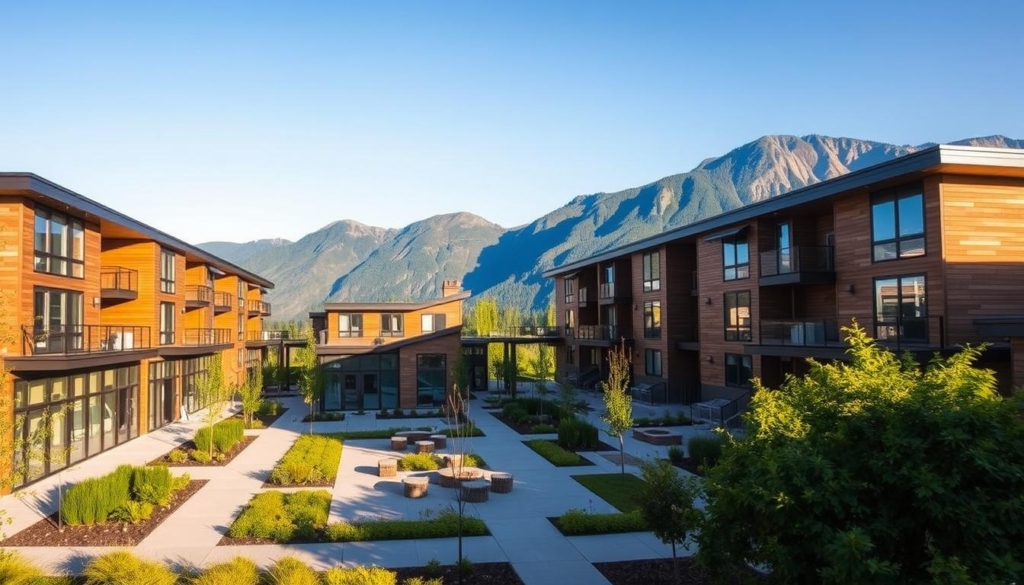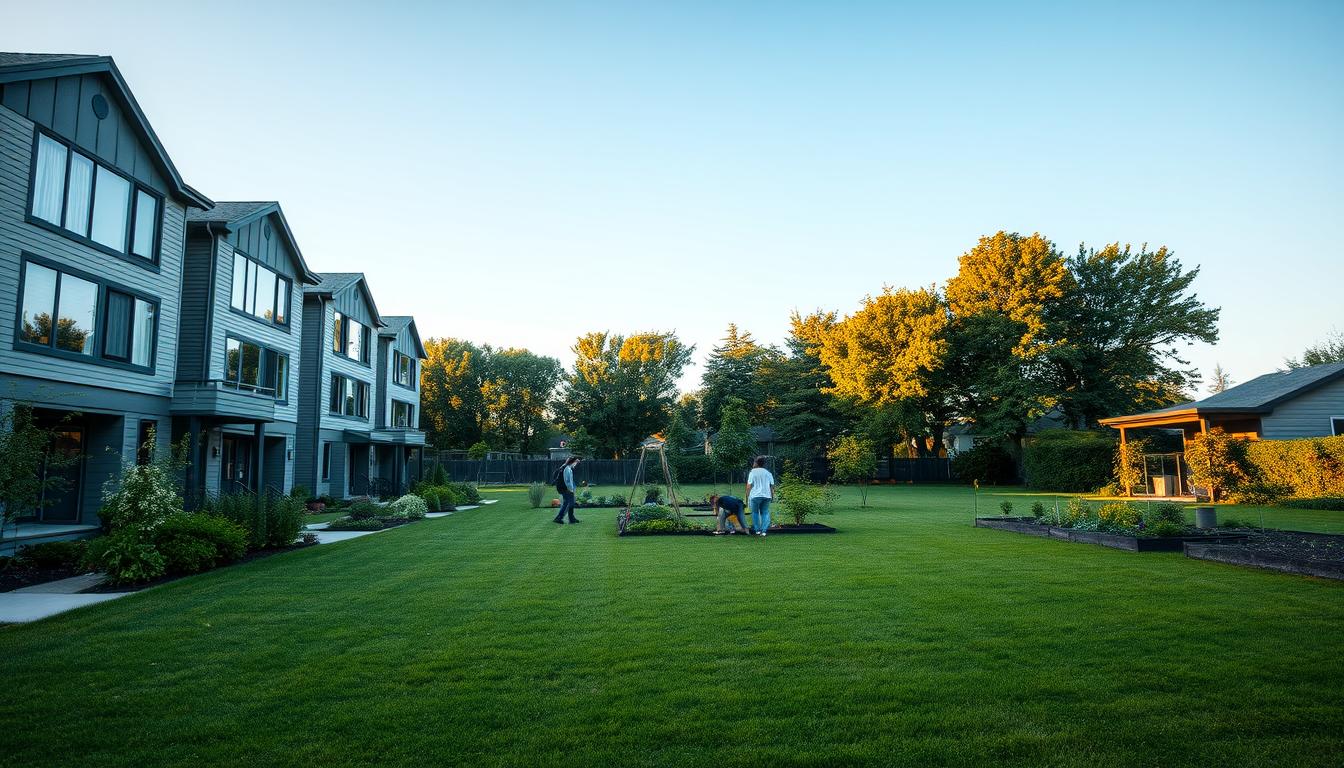Co-op housing is a special way to own property in Canada. It’s different from buying a house or apartment. Instead, you buy shares in a company that owns the whole building.
When you live in a co-op apartment, you own a share of the property. You get to live in a specific unit. But you also help make decisions for the whole building. This way, everyone has a say in how the place is run.
New Homes Alberta helps people understand co-op housing. Our team knows a lot about this unique way of owning a home. We guide our clients through the process of buying a co-op apartment in Canada.
If you’re interested in co-op living, call us at (403) 305-9167. Our team will give you all the details you need. We’ll help you see if co-op housing is right for you.
Key Takeaways
- Co-op apartments involve purchasing shares in a corporate property structure
- Residents gain exclusive occupancy rights through share ownership
- Members participate in collective property management
- Co-op housing ranges from townhouses to large apartment complexes
- Offers unique community-driven approach to residential living
Understanding Co-op Housing Fundamentals in Canada
Co-op housing is a special way to live where everyone works together. In Canada, it’s a new way to own a home. It lets people live in a community where everyone has a say.

In co-op housing, people own the place together. They make decisions and help run things. It’s different from owning a home alone.
Key Features of Co-op Housing
- Collective ownership of property
- Democratic governance through elected boards
- Shared financial responsibilities
- Diverse community representation
The Corporate Structure
Co-op housing works because of the rights of its members. Each member owns a share. This lets them live in a unit and help manage the place.
Member-Owned Housing Model
Co-ops are special because they’re owned by the people who live there. Members help decide how things are run. They go to meetings, pay fees, and make big decisions.
Co-op housing transforms residents from passive tenants into active community stakeholders.
Co-ops in Canada are open to all kinds of people. They have homes for students, artists, and seniors. This makes sure everyone finds a place that fits their needs.
What Is a Co-op Apartment: Basic Concepts and Definitions

A co-op apartment is a special way to own a home. It’s different from buying a house or condo. Here, people buy shares in a company that owns the whole building. This makes living together a shared experience with everyone working together.
To understand co-op apartments, you need to know about shared ownership. Unlike condos, where you own your unit, co-op owners own the whole building. They buy shares that let them live in a specific unit.
- Shareholders have voting rights in the cooperative
- Monthly maintenance fees cover operational expenses
- Approval process for new residents is typically more rigorous
- Shared decision-making is a fundamental characteristic
Co-op vs condo ownership has big differences. Co-op owners don’t build equity like condo owners do. They own shares in a company that runs the building. This means buyers must get approval from the co-op board, making it a more exclusive option.
Cooperative housing represents a democratic approach to property ownership, where community and shared goals take precedence over individual investment.
In Canada, co-op housing is very popular. Places like Ontario, Quebec, Alberta, and British Columbia have lots of co-ops. For example, Ontario has over 550 non-profit housing co-ops, home to more than 125,000 people.
The Evolution of Co-op Housing in Canada
The story of co-op housing in Canada is one of community and progress. It started small and grew into a big part of our housing scene.

The Antigonish movement in Nova Scotia was the start. It showed the power of working together for housing. The first student co-ops, like the one at the University of Toronto in 1936, were big steps forward.
Historical Milestones
- 1966: Willow Park Housing Co-op in Winnipeg showed growth beyond schools
- 1968: CHF Canada was formed to help more co-op housing
- 1973-1978: The government helped create about 7,700 co-op homes
Modern Co-op Communities
Today’s co-op housing offers many amenities for modern living. These places have shared spaces and resources, making them lively communities.
Current Statistics and Growth
Today, co-op housing in Canada is thriving. There are over 92,000 units, home to about 250,000 people. Almost 2,200 non-profit buildings are across the country.
The 2017 National Housing Strategy gave $40 billion over 10 years for co-op housing.
Co-op housing is always changing, with new ideas and government help. This is making more affordable homes for Canadians.
Co-op vs. Condo: Understanding the Key Differences

Understanding the Canadian real estate market means knowing the difference between co-op and condo ownership. Both offer housing options, but they handle property ownership differently.
The main difference is in the co-op ownership structure. Unlike condos, co-op residents buy shares in a corporation that owns the building. This model has several key differences:
- Ownership Rights: Condo owners get a deed to their unit, which can be used for loans.
- Approval Process: Co-op purchases need a thorough board screening, including financial checks and interviews.
- Financial Implications: Co-ops often ask for higher down payments (20-30%) but may have lower monthly costs.
Governance is another big difference. Co-op boards have a lot of power over rules, who lives there, and how the building is managed. This means getting into a co-op is more complex than buying a condo.
Co-ops have unique financial aspects:
- Lower initial costs
- Slower property value growth (1-3% a year)
- Monthly fees cover mortgage, taxes, and utilities
The co-op model focuses on community unity and group decisions over individual rights.
In cities like Toronto and Vancouver, co-op housing is more common. This shows their focus on community living. Buyers need to think about what they value most: flexibility, community, or financial aspects when choosing between co-op and condo living.
The Financial Structure of Co-op Housing
Co-op housing has its own financial model. It’s different from buying real estate the usual way. Understanding this is key for anyone interested.
Co-op housing has several important parts. These are things to know before you join:
- Share purchase process requires a big upfront investment
- Monthly maintenance fees cover many costs
- There are specific financial rules for joining
Share Purchase Process
When you join a co-op, you buy shares, not the property itself. These shares are usually 20% to 50% of the price. Co-op financing options include special loans that use these shares as collateral.
Monthly Maintenance Fees
Co-op fees cover a lot, like mortgage payments, repairs, insurance, and taxes. These fees are often higher than condo fees. But they help take care of the building.
| Fee Component | Typical Coverage | Average Cost Range |
|---|---|---|
| Mortgage Contribution | Building-wide mortgage payments | 20-35% of total fees |
| Maintenance | Repairs and upkeep | 25-40% of total fees |
| Utilities | Shared building utilities | 15-25% of total fees |
| Reserve Fund | Future major repairs | 10-20% of total fees |
Financial Requirements for Members
Co-op boards check your finances closely. They look at:
- Credit score verification
- Income documentation
- Debt-to-income ratio assessment
- Potential interview process
Be ready with detailed financial info. It shows you can help the co-op financially.
Co-op Board Structure and Governance
The way a co-op housing community is run is special. It’s based on a democratic system. The co-op board is key in keeping the community’s vision alive, its finances healthy, and everyone happy. Knowing how the co-op board works helps people understand what it’s like to live in a co-op.
Getting approval from the co-op board is very important. The board is made up of elected members who are also shareholders. They make sure the community’s needs are met. They handle things like:
- Setting community rules
- Managing money
- Keeping the place in good shape
- Looking out for the rights of shareholders
Choosing board members is open and fair. Shareholders vote to pick people who will make big decisions for the community. This way, everyone has a say in how their home is run.
Co-ops can be different, depending on their goals. Some focus on helping older people or specific groups. Others aim to help more people. The main thing is to balance what’s good for each person with what’s good for everyone.
It’s important to know that getting the co-op board’s approval is not just a formality. It’s a way to keep the community’s spirit alive, make sure it’s financially sound, and protect everyone’s interests.
Rights and Responsibilities of Co-op Shareholders
Becoming a co-op shareholder means knowing your rights and duties. These are different from owning a house. In Canada, co-op housing is a place where people live together, sharing expectations and protections.

Co-op shareholders have more than just a place to live. They join a democratic community where they can make decisions.
Voting Rights and Community Engagement
Shareholders in co-op housing have important voting rights:
- Vote on big building decisions
- Choose the board of directors
- OK the annual budget
- Go to community meetings
Maintenance Obligations
Co-op fees and upkeep duties are shared. Each member pays a part of the building’s care through monthly fees. These cover:
- Real estate taxes
- Building insurance
- Keeping common areas nice
- Utility costs
| Shareholder Right | Corresponding Responsibility |
|---|---|
| Occupy Unit | Pay Monthly Fees Timely |
| Participate in Governance | Attend Community Meetings |
| Safe Living Environment | Follow Co-op Bylaws |
Living in a co-op is about working together. It balances personal needs with the good of the community.
The Co-op Application and Approval Process

Getting into a co-op requires careful planning and knowing how co-ops work. Buyers need to understand that co-ops have their own rules, unlike regular houses.
The application process has key steps:
- Preparing a detailed board package
- Gathering financial documents
- Getting reference letters
- Scheduling a board interview
Being financially stable is key for approval. You need to show:
- A good credit score
- A low debt-to-income ratio
- Enough liquid assets
- A stable income history
The cost of buying shares varies by co-op. Nonprofit co-ops usually charge $2,000 to $7,000. Equity co-ops might cost more like a regular house. Credit unions offer flexible loans, unlike banks.
Getting approved is not just about money. It’s about fitting in with the community and being committed.
Applicants must prepare well. This includes employment checks, financial reports, and personal references. The board interview is a chance to show you’re a good fit for the co-op’s values.
Financing Options for Co-op Purchases
Understanding co-op financing is key. It’s different from buying a house. Co-op financing has its own set of rules and benefits.
Buying shares in a co-op needs special financial plans. You must know the co-op’s structure to get the right loan.
Share Loan Fundamentals
Share loans are a big part of co-op financing. They use the co-op share as collateral. This makes borrowing unique. Here are some important points:
- Typically require 10% to 20% down payment
- Fewer lenders offer co-op share loans
- Strict financial review of both buyer and property
Traditional Financing Strategies
Credit unions are often the best choice for co-op loans. They get the co-op ownership structure better than banks.
Buyers should be ready for a detailed financial check. Lenders look at:
- Individual financial health
- Co-op corporation’s financial stability
- Overall property financial performance
Knowing these details helps co-op buyers make smart choices.
Co-op Housing Maintenance and Operations

Co-op housing maintenance is a team effort. The co-op board of directors oversees daily operations. They make sure the community runs well. They handle co-op fees and maintenance to keep the property in top shape.
Co-op housing splits maintenance duties between individuals and the community. Shareholders take care of their units. The co-op looks after common areas and shared facilities.
- Individual unit maintenance: Shareholders responsible for interior repairs
- Common area maintenance: Co-op board manages shared spaces
- Shared facilities upkeep: Hallways, lobbies, elevators, and building systems
Co-op amenities and facilities are a big part of the housing model. These include recreational spaces, fitness centers, parking areas, and community rooms. The co-op fees cover these costs and help improve the facilities.
| Maintenance Responsibility | Managed By |
|---|---|
| Individual Unit Repairs | Shareholders |
| Common Area Maintenance | Co-op Board |
| Shared Services | Co-op Management |
Members have rights in maintenance and operations. They can ask for inspections if 10% support it. The co-op board must act for the community’s good. They ensure systems work well and follow bylaws.
Co-ops are legally obligated to maintain property standards and provide essential services like heat, hot water, and electricity to all members.
Legal Framework and Regulations for Co-ops in Canada
Co-op housing in Canada has a complex legal landscape. It involves provincial and federal rules. These laws protect both individual and group interests.

There are key areas to understand in the legal world of co-op housing:
- Provincial laws affect co-op shareholder rights
- Federal rules set overall guidelines
- Not-for-profit laws outline how co-ops operate
Provincial Legislative Landscape
Each province in Canada has its own co-op laws. This means the rules can vary a lot. It’s important to research the local laws carefully.
| Province | Key Legislative Features | Shareholder Protections |
|---|---|---|
| Alberta | Specific eviction procedures | 14-day notice requirements |
| Ontario | Detailed board governance rules | Democratic voting mechanisms |
| Quebec | Unique tenancy law applications | Enhanced member rights |
Federal Guidelines
The Canada Cooperatives Act sets basic rules for co-ops nationwide. It makes sure co-op rights are protected everywhere.
“Cooperatives operate on principles of democratic control and collective benefit” – Canadian Cooperative Association
Co-ops must follow these federal rules:
- They must be open to all
- Members have a say in decisions
- They can’t make too much profit
- They focus on helping the community
Knowing these laws helps people make smart choices about co-op housing. It protects their rights and the group’s goals.
Benefits and Challenges of Co-op Living

Co-op housing is a special way to live where everyone owns a share. It combines community spirit with shared ownership. This model has its own perks and downsides for those looking for different housing options.
The good things about co-op living go beyond what you find in regular houses:
- Affordable housing opportunities
- Strong community connections
- Collaborative decision-making processes
- Shared co-op amenities and facilities
Money matters a lot in co-op living. People get to share costs and benefits through collective ownership.
| Benefit Category | Key Advantages |
|---|---|
| Financial | Lower initial costs, shared maintenance expenses |
| Community | Enhanced social connections, mutual support |
| Governance | Democratic decision-making, resident control |
Potential challenges in co-op living need careful thought:
- Strict approval processes
- Limited personal modification rights
- Complex resale procedures
- Potential additional assessment fees
Prospective co-op residents must weigh their personal preferences against these possible limitations to decide if it’s right for them.
Market vs. Subsidized Co-op Units

Co-op housing in Canada comes in two types: market and subsidized units. These options help people with different incomes find homes. They make communities where everyone can afford to live.
Market units cost what the real estate market says they should. People buy shares in these units. The cost of shares is usually between $1,000 and $7,000. Buyers need to show they can afford it.
- Market units priced at current real estate rates
- Direct share purchase required
- Standard co-op fees and maintenance expectations
Subsidized units are a special way to make housing affordable. They get help from the government or non-profits. This makes the cost much lower, sometimes just 25% of what market units cost.
| Unit Type | Average Monthly Cost | Qualification Criteria |
|---|---|---|
| Market Units | Full market rate | Standard financial screening |
| Subsidized Units | 25-33% below market rate | Income-based eligibility |
Programs like the Federal Community Housing Initiative help with subsidized units. They help co-ops keep housing affordable. This makes communities more diverse.
People can apply for these units directly or through programs like MyAccesstoHousingTO. This helps find the right housing for everyone.
Resale Process and Regulations in Co-op Housing
Selling a co-op apartment is different from regular real estate sales. The co-op resale process has unique steps that sellers must follow. Instead of selling the property, co-op shareholders sell their membership shares.
The co-op board’s approval is key in this journey. Buyers must go through a detailed review. This review checks their financial health and if they fit in with the community.
Transfer of Shares
When selling co-op shares, there are certain rules to follow:
- Notify the co-op board of your plan to sell
- Submit all financial documents
- Be ready for an interview with the board
- Follow the first-right-of-refusal rules
Board Approval Requirements
Getting the co-op board’s approval is essential. The board looks at buyers carefully:
| Evaluation Criteria | Typical Requirements |
|---|---|
| Financial Stability | Proof of income, credit score, savings |
| Community Fit | Personal interview, references |
| Debt-to-Income Ratio | Typically below 30% |
The co-op resale process is more complex and takes longer than regular sales. The board’s decision is final. So, being well-prepared and open is very important.
Conclusion
Understanding what a co-op apartment is is key for those looking into different housing options in Canada. The co-op ownership structure is a unique way to own a home, unlike traditional real estate. It offers a chance to live in a community where everyone works together, making it affordable and engaging.
Co-op housing is a new way to own a home, where everyone works together to manage it. This means you can live in great places for a set price each month. Plus, you get to share costs and enjoy a community feeling that’s hard to find elsewhere.
If you’re thinking about co-op apartments, New Homes Alberta suggests doing your homework and getting advice from experts. It’s important to think about your budget, how much you want to be involved in the community, and what you want from your home in the long run. Our team is here to help you make the right choice.
Want to learn more about co-op housing in Alberta? Call New Homes Alberta at (403) 305-9167. Our experts can guide you through the co-op ownership process. They’ll help you see if this housing model fits your needs and goals.





